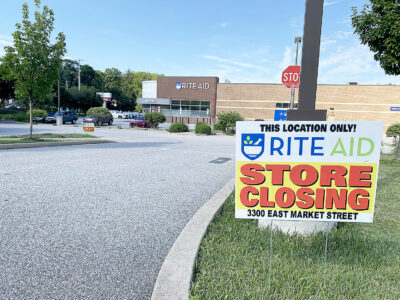Springs along roadsides carry risk
In June, when Niagara Bottling announced that the company’s bottled water produced in Pennsylvania might contain E. coli bacteria, it left worried consumers in 14 states scrambling to check manufacturing codes and expiration dates.
Similar recalls in recent years have been reported prominently, with even the slightest risk of infection raising customers’ concerns.
Those same customers might not realize the fresh, flowing water close to home could be much riskier. Studies as recently as this year have shown most of Pennsylvania’s popular roadside springs tested fail basic drinking-water standards – and other popular sources often go without any testing or purification.
“They think because it’s natural, it’s safe to drink,” said Jim Clark, a Penn State University Extension water resources educator based in McKean County. “Drinking (spring water) without treatment and without further testing is not healthy.”
Despite the risk, travelers equipped with bottles and plastic jugs remain a common sight along roads and at public taps, collecting water that could contain E. Coli, intestinal parasites and even concentrated lead.
Passionate about water
There’s little doubt, based on the data, that Pennsylvanians love their freshwater springs.
According to a Penn State Extension 2014-15 survey of more than 1,000 people, some 30 percent said they collect water from roadside springs at least occasionally. More than one in 10 said they do so regularly.
That’s on top of the sizable portion of Pennsylvanians who rely on private, household spring water that bubbles naturally to the surface in rural areas.
According to a Penn State map using U.S. Census data, between 20 and 30 percent of Cambria, Centre and Clearfield County residents use spring water, while 10 to 20 percent of Huntingdon and Bedford County residents and 5 to 10 percent in Blair County do so.
“Many of them are very passionate about it,” Clark said.
Asked why they use public springs, a large number of those surveyed said they liked the idea of “natural,” untreated water. On websites used by outdoorsmen and travelers to catalog and track public springs, some visitors lament water supplies that turn out to contain bacteria-killing chemicals.
“Unfortunately, after talking to the rangers, we discovered that they do add chlorine to the water,” one typical visitor said of a Westmoreland County spring based in a park.
Typically located in the public right-of-way along forest roads, the spring taps can sometimes discharge more than 30 gallons per minute in peak months.
While fresh, cold water trickling from a woodland spout might look clean, Penn State researchers, including Clark, have repeatedly found that looks can be deceptive.
Bacteria dangers
In 2013, a team of researchers tested 35 roadside springs across the state, including several in Centre County and one outside Johnstown. While they
didn’t survey Blair County, roadside springs can be found here too – including one in a shady pull-off along Puzzletown Road in Juniata Township.
The 2013 results were revealing: 32 springs, representing 91 percent of the total survey, contained total coliform bacteria. While not necessarily harmful in itself, total coliform bacteria can often be an indicator of other, more dangerous pathogens, according to the U.S. Environmental Protection Agency.
Twelve of the springs, totaling 34 percent, contained E. coli bacteria. Federal water standards call for zero E. coli, which can cause serious digestive illness commonly recognized as food poisoning.
A second, smaller-scale review in 2014 and 2015 found further evidence of risk: Seven of eight springs tested contained giardia and cryptosporidium, microorganisms that can cause weeks of gastrointestinal illness, even in otherwise healthy patients.
In all, the Penn State Extension review found that 97 percent of the state’s roadside springs fail at least one drinking water standard.
While springs can be contaminated through several routes, Clark pointed to animal waste as a common cause in smaller, household sources. A spring bubbling to the surface might attract a group of deer overnight, for example; those deer would likely leave waste nearby.
“There’s a good chance you’re going to have a high bacteria count in the morning in your water,” Clark said.
Precisely how often these risks lead to human illness is harder to quantify. Clark said local researchers haven’t found a direct link between a roadside spring and a case of stomach illness, but on multiple occasions, homeowners have reported sickness before realizing their private springs had high bacteria counts.
If you lay a county-by-county map of giardia cases over a map of household spring use, they clearly match, he said.
Public but untested
For many secluded springs, public knowledge is passed on through word-of-mouth over the decades. They can be easy to miss if you’re just driving by.
But locally, one is unique in its prominence.
In Roaring Spring, the limestone spring that lent the town its name continues to flow to the surface, pouring from a tap at the far end of the borough’s popular park.
The spring is central to the town’s life and economy: It feeds the municipal water system and serves a paper mill, a paper products company and Roaring Spring Water, which serves three states. On a nice day, it’s not uncommon to see visitors filling jugs with fresh water in the park.
And although the spring’s corporate and government users take pains to clean and purify their products, the water flowing straight from the spring remains unregulated and largely untested, officials said.
“The water that comes out at the back of the spring is not treated,” Roaring Spring Water General Manager Scott Hoover said. “We’re not responsible for it.”
Roaring Spring Water uses ultraviolet light to kill bacteria and injects ozone into its supply to ensure the water is clean, Hoover said. The borough’s municipal authority also purifies its water before storing it nearby and sending it on to homeowners.
But for those drawing their water directly from the source, there’s no such guarantee of cleanliness. A Pennsylvania Department of Environmental Protection official said the department hasn’t tested the spring recently, and Roaring Spring Mayor Ron Glunt said the local government doesn’t directly oversee the spring.
“We haven’t had any problems or anything,” Glunt said of the water.
There’s no indication anything is wrong with water from the borough’s namesake spring. But, despite its more prominent location, it is comparable to the roadside springs Clark and the Penn State Extension team tested over the past three years.
Hoover noted that even unpurified spring water isn’t inherently unsafe – many popular European sparkling water brands aren’t purified – and said even the presence of some bacteria is far from a guarantee of illness.
“The only way you know is if you get sick,” he said.
Who is responsible?
Part of the reason a single authority isn’t responsible for the spring’s water is its long history of shared control. The spring’s surface pond and tap are located in a publicly accessible park but not owned by the government, and several companies use its supply.
“It’s complicated,” Hoover said.
Their situation highlights a problem common to many public and roadside springs: No one clearly owns them, so no one exercises direct control.
“It’s mostly on the back roads or in the rights-of-way on rural roads,” said Clark of the Penn State Extension. “They’re usually not in the center of a town park. They’re in backwoods, rural areas.”
In a few cases, businesses and public agencies have moved to close the springs or make them less accessible. On FindASpring.com – a website travelers use to identify water sources – several Bedford County residents complained in 2011 that a longtime tap near the Bedford Springs resort had been shut off with the arrival of Omni Hotels & Resorts.
In Bellefonte, the local government keeps its well-known spring covered and inaccessible to the public, Borough Manager Ralph Stewart said. While small towns occasionally rely on bubbling springs for their public supply, few have open access like Roaring Spring, Stewart said.
“It’s not too often that a spring is a water source. Most of the time, because of contaminants and security issues, they’re not open to the public,” he said.
But some municipalities take the opposite route, providing easier access, Clark said. In a few cases, local governments will pave access points near roadside springs to ensure stopped motorists’ safety.
While that’s a helpful service, it could complicate legal matters if and when a drinker becomes sick, Clark said.
“The question becomes, what’s the liability of doing that? The liability issue just hangs over everybody,” he said.
‘Nobody’s going to tell me’
There seems to be little chance most popular roadside springs will be closed, Clark said, and no one remains responsible for testing their water. As it stands, the best hope is to educate the public about the risks, he said.
Those who’ve long visited a local spring might not notice any ill effect, having long since adjusted to the bacteria – but the concern always remains for new or outside visitors, Clark said. A series of Penn State Extension seminars has spurred at least a few people to give up on the springs, he said.
Part of the problem is the lack of a single, clear solution, even for those willing to purify the water themselves. Bringing it to a rolling boil will kill most bacteria, he said, but can also concentrate existing lead to higher levels.
Convincing the public to leave the springs entirely – or at least to ensure they’re safe – could be a slow battle, however.
“People are passionate about the springs,” he said. “They say, ‘Nobody’s going to tell me not to drink my water.'”





